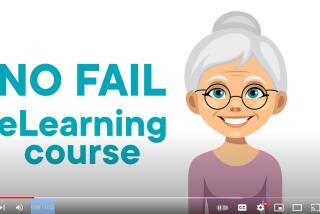HealthCare.gov site stumps ‘highly educated’ millennials. Here’s why
- Share via
Millennials who struggled to sign up for health insurance on HealthCare.gov have some simple advice for the Obama administration: Make the website more like Yelp or TurboTax.
President Obama famously told doubters that they could use the government’s health insurance site to pick a health plan “the same way you shop for a plane ticket on Kayak, same way you shop for a TV on Amazon.” Speaking at a community college in Maryland last fall, he promised that the process was “real simple.”
That turned out not to be the case, of course. A study published Monday by Annals of Internal Medicine lays out some of the specific ways that HealthCare.gov – a centerpiece of the Patient Protection and Affordable Care Act – went wrong.
A team of doctors, lawyers, health economists and health policy experts from the University of Pennsylvania recruited 33 volunteers and observed them as they struggled to sign up for health insurance on the highly touted website. These volunteers should have been in pretty good shape: With ages ranging from 19 to 30, they were all members of a Web-savvy generation. In addition, the study described the young adults as “highly educated.”
But when they got to HealthCare.gov, they ran into problems. Some of them had anticipated that they could type in their preferences – what services they wanted to have covered, how much they wanted to spend on premiums, how much flexibility they want in picking their doctors – and get a list of options that met their criteria. (It could have been the health insurance equivalent of using Yelp to find a sushi bar near Santa Monica that has outdoor seating and takes reservations.)
Instead, the volunteers had trouble matching their preferences with actual plans, according to the study. The research team said this was partly because of the “overwhelming” amount of information the website displayed.
As one of the volunteers told the study authors: “I would love a tool where it’s, like, is it important that you have dental coverage? Check this box. Do you want mental health coverage? Check this box.... [A]nd then have it generate: These are the plans that most closely meet your needs.”
Another hurdle was vocabulary. Plenty of terms on HealthCare.gov were “inadequately explained,” as the study authors put it. What is the difference between a PPO, an HMO and an HSA? How is a deductible different than a co-pay? When site users ran into these confusing terms, they got stuck.
“It’d be nice if they had something like they do on TurboTax, how you can, like, scroll over and it opens up a little help window that explains a bit more,” one of the volunteers said.
Not only could these pop-up bubbles explain the meanings of unfamiliar words, they could also give concrete examples of how a plan’s features would work, the study authors added. That way, they could get a clear idea of how a plan with higher monthly premiums would have a lower deductible, for instance.
One vocabulary word gave the volunteers some special trouble: catastrophic. In normal use, it means something disastrous. In the health insurance context, it describes a plan for people who don’t expect to go to the doctor very much.
For some of the volunteers, the first meaning of “catastrophic” overwhelmed the others.
“It sounds like a scare tactic; but they’re pushing us toward these plans with the low price,” one volunteer said. Another assumed that such plans would “only offer you coverage in times of unexpected and immediate health concerns. So, like, routine visits, for example, would be uncovered.” (That’s not true: preventive primary services are covered in all plans.)
The researchers suggested that the website come up with a new name for these plans, such as “value” or “minimal.”
HealthCare.gov also got poor marks for presenting the true costs of various plan choices after tax credits and cost-sharing options were taken into account. Many of the volunteers discovered that comprehensive health plans in the silver category were actually cheaper than the no-frills catastrophic plans, but the reasons for this weren’t clear.
The good news, according to the researchers, is that these problems should be simple to fix. “Young adults in this study revealed how small changes to HealthCare.gov could improve their understanding of a typically difficult process,” they wrote.
But if anyone in the Obama administration is inclined to take this advice, he or she had better get to work – open enrollment begins again on Nov. 15.
Follow me on Twitter @LATkarenkaplan for more news about health and medical research.







